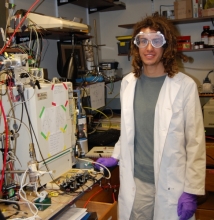
Major:
University:
Mentor(s):
Faculty Sponsor(s):
Faculty Sponsor's Department(s):
Project Title:
Project Description:
Most molecular-scale studies on heterogeneous catalysis have been performed under Ultra-High Vacuum (UHV) conditions on single crystal planes. However, actual catalysts are high surface area supported nanoparticles with a distribution of surface sites that are used at high pressure conditions. We would like to bridge this gap between research and application by performing catalytic studies on platinum nanoparticles of controlled shape so as to correlate available surface sites with catalytic activity and selectivity, specifically for the partial hydrogenation of acetylene. The platinum nanoparticles were synthesized using the long-chain polymer polyvinylpyrrolidone (PVP) as a capping agent to prevent aggregation and the inorganic complex silver nitrate in varying concentrations to selectively produce different shapes (cubes, cuboctahedron, octahedron). To identify different surface sites, carbon monoxide (CO) was adsorbed onto the platinum nanoparticles and monitored using infrared spectroscopy. Using thermogravimetric analysis, we have determined that the most effective way of removing the PVP capping agent from the nanoparticle surface is by thermal treatment of the supported catalyst at 300oC under alternating oxidizing and reducing conditions. Additionally, using infrared spectroscopy on adsorbed CO, we have begun to identify different surface sites on different shaped nanoparticles that we can relate to catalytic activity and selectivity for the hydrogenation of acetylene. We have developed a procedure for removing the PVP capping agent while maintaining the particle size and we have demonstrated the general applicability of using infrared spectroscopy on adsorbed CO to identify surface sites that can be correlated with catalytic activity and selectivity.
